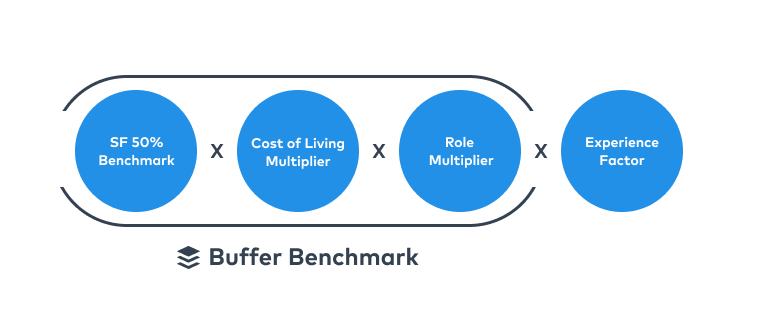Compensation has always been a thorny issue. Whether to talk about it, how to talk about it, follow precise grids or value on a case-by-case basis, how to fairly consider the location of employees... For Buffer, whose team is distributed across the globe and whose key value is transparency, it's a very important topic they've chosen to spend time on! Today, their compensation calculation formula is public, and everyone can access it.
Transparency is a fundamental value at Buffer, a social media account management platform and a company without offices. It's even the second value displayed in the "Buffer Culture" (which is intended to evolve over time): "Default to transparency." It encourages everyone not to miss an opportunity to share their beliefs, decisions, but also their failures.
As early as 2013, Buffer decided to publish its revenues, number of users, and progress reports detailing the operation and performance of its customer service. Everyone's salaries are also published, following lengthy discussions and with the agreement of all employees.
Transparency breeds trust, and trust is the foundation of great teamwork. - Joel Gascoigne, founder and CEO of Buffer
The company chose to go even further by developing a formula, also made public, that determines everyone's income. This allows, on one hand, to remain fully consistent with a culture based so much on transparency and equity. It's also a way to better manage salary negotiations for candidates and employees.
It must be admitted that the calculation, done by the HR and finance teams, is not simple... Employees are scattered all over the world, and if the company wants to be transparent, it also wants to be fair! Not every employee faces the same "cost of living," and this must also be taken into account in the compensation calculation.
A first formula...
In December 2013, a first formula was created:
salary = profession x grade x experience x geographical location (+ 10% if a salary increase is preferred to obtaining company shares)
An engineer starts with a base of $60,000, for example. The position determines a percentage that is added (10% for a VP). Experience affects a coefficient overall: a junior has a coefficient of 1, while it's 1.3 for a "master." For location, living in San Francisco or London costs more than in Manila or Delhi: this adds an additional $22,000. For more details, you can consult them here.
Then, a second one...
Just like the "Buffer Culture," this formula is "alive." Its purpose is to evolve over time to always remain relevant and fair. Thus, in 2015, a second formula was applied, aiming to better reflect differences in the cost of living:
salary = [(position x experience) + choice between salary or shares] x loyalty
Buffer wanted to integrate labor market prices (not just the cost of living) while limiting the intensity of differences (the gap was $90,000 between San Francisco and Cape Town, for example). They added the notion of position, which depends 35% on the average displayed in the American market and 65% on the listed cost of living (this information is extracted from specialized websites and organizations). Another novelty is loyalty: for each year spent at Buffer, the employee receives a 5% increase that applies to the entire formula.
But even then, not everything is perfect: geographic location affects the perception of the value each person brings to the company, and case-by-case adjustments complicate the calculation.
And a third one...
In 2017, a third formula was proposed. To simplify, Buffer preferred to take a common base of prices. They chose those of San Francisco... one of the most expensive labor markets! Many doubts were expressed then. Some estimated that it would cost too much, while others argued that it was unnecessary to be more generous than what employees expect. This new formula has at least the advantage of adapting to digital nomads, who work for Buffer while traveling around.

This time, the cost of living is compared to the median market price of San Francisco. This is weighted by a cost of living factor (100% for "high," 85% for "medium," 75% for "low"). The role corresponds to the profession, used in the first version of the formula. More details here.
Want to calculate what it would be for you if you worked at Buffer in 2015? It's possible here!
The feedback is generally positive: for Arielle, using a formula makes it possible to explain a compensation system that can easily become taboo in a less transparent context. Furthermore, it addresses sensitive issues such as gender inequalities. Hailley, on the other hand, has noticed that with the use of this formula and the associated transparency, a new field of conversation about the financial aspects of the company has opened up.




